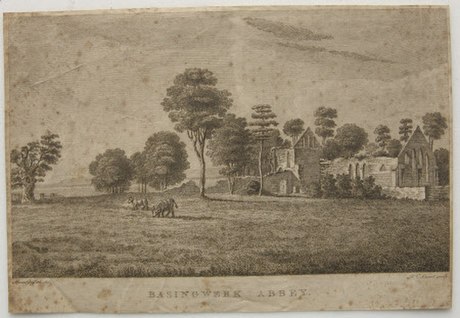Moses Griffith (6 April 1747 – 11 November 1819) was a Welsh draughtsman, engraver and watercolourist.


Griffith was born at Trygarn House in the parish of Bryncroes on the Llŷn Peninsula, Caernarfonshire.[1] His parents were of humble station, and he received a very elementary education but his artistic talent led to his being taken into service by Thomas Pennant[2] about 1769. Pennant helped him to study drawing and engraving, and Griffith became his constant companion on his tours and excursions, making the drawings and engravings for Pennant's numerous works. Griffith became proficient both as a draughtsman and as an engraver.[3] Griffith accompanied Pennant during his Tour of Wales and also visited Scotland, this became a basis of his career between 1769-1790. After Thomas' death, Griffith was employed by his son David and produced nearly 200 watercolors in Wales for him between 1805-1813.[3]
On leaving Pennant's service he settled at Wibnant, near Holywell, Flintshire, where he obtained plenty of employment as an engraver. He was alive in 1809, when he wrote a letter defending himself from an attack to the Gentleman's Magazine.[4] Francis Grose employed Griffith to engrave some of the plates in his Antiquities.
Griffith also painted watercolours of Welsh scenes, churches, country houses, and portraits, including two self-portraits. His work is to be found in National Museum of Wales, British Museum and the Victoria and Albert Museum.[3]
Works
- An original watercolour of Clynnog by Griffith (1782), from the National Library of Wales' extra-illustrated set of A Tour in Wales.
- Lobelia dortmanna drawn by Griffith, engraved by Peter Mazell, from John Lightfoot's 1777 Flora Scotica
- "Long Leg'd Plover" (black-winged stilt) in Flora Scotica, one of a few birds in the book. Drawn by Moses Griffith; engraved by Peter Mazell
- A miniature of Basingwerk Abbey from a unique set of eight extra-illustrated volumes of Thomas Pennant's A Tour in Wales owned by the National Library of Wales.
- Another image of Basingwerk Abbey from Pennant's A Tour in Wales.
- Nannau painted by Moses Griffith.
- Old Nannau sketch by Moses Griffith 1797, built by Huw Nanney, circa. 1697.
References
Wikiwand in your browser!
Seamless Wikipedia browsing. On steroids.
Every time you click a link to Wikipedia, Wiktionary or Wikiquote in your browser's search results, it will show the modern Wikiwand interface.
Wikiwand extension is a five stars, simple, with minimum permission required to keep your browsing private, safe and transparent.







